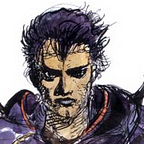I may be late on writing these reviews, but that doesn’t mean I couldn’t sneak in a bonus game for yall. This one’ll be short, though.
Dragon Slayer, the very first game in the franchise now far better known via sub-series The Legend of Heroes (itself famous for its own sub-series, Trails, itself famous for its own sub-series, Trails of Cold Steel) marks my dive into the belly of a leviathan, folks. While I have no plans to play the entire overarching series in release order, I did want to at least try the first entry before checking out the later, more well-known games.
As such, I didn’t know what to expect heading in. I quickly found out it’s an action RPG, though calling this “action” might be pushing it. The game reveals heavy arcade influences, which makes sense considering the original released in 1984, before modern consoles took off (though I played the Saturn remake). It locks you to a grid, forcing you to take a single step at a time, and also includes a bunch of ideas that seem off-the-wall today but remind me of various arcade and ancient home computer games I’ve seen over the years, like pushing blocks around, walking into enemies to attack them, and heavy punishment for failure.
At the same time, Dragon Slayer acts as one of the most important bridges between arcade stylings and modern RPG sensibilities—this pioneering proto-RPG was a hit in Japan, after all—by adding the stats, MP, and experience that get raised through gameplay, an increasing list of spells to cast, The action takes place on a single scrolling map that loops around on itself, like a lot of arcade games but, funnily enough, also like most of the classic JRPGs from the decades that followed. In Dragon Slayer, it’s implied you’re adventuring through a world that’s much bigger than what you see. As you travel from your little house to the terrifying boss dragon in the far corner, it’s clear you’re not supposed to be thinking about how close it would be had you been able to cross the mountains and go the opposite way. The coolest thing about the game, however, is that eventually you can do just that.
Dragon Slayer’s got three main “equippable” items your hero can pick up, but he can only hold one at a time, leaving to a lot of not-fun backtracking. For example, the power ring lets you slide blocks around, opening access to new areas and plenty of those sweet, sweet treasure chests, but you’ll need to be holding the key in order to open them. Worse, if you set an item down, there’s a chance this annoying bird creature that flies around randomly will swoop down and carry it off to another spot on the map. That’s the kind of classic arcadey mechanic I don’t miss in games today, purely an annoyance put into to the game as a holdover from an era where difficulty and time spent was the content. Lastly, crystals can be taken back to your home base to raise your strength stat, which means—you guessed it—even more backtracking. At least these buffs are useful, since monsters hit hard, though it’s hilarious how much stronger you get from a single crystal. Still, you’ll need tons more to have any hope of taking on the dragon, who made short work of me the first time I got curious and entered his domain.
Coins, the most common chest reward, can be picked up without taking up inventory space and then returned to home base for a health upgrade. Why the game makes you carry crystals one by one but not coins puzzles me, but hey, it was the mid-80s: wacky game mechanics were in. Finally, magic jars increase your MP by one when you pick one up—there’s no concept of maximum stats here, you just have whatever MP you’ve got, and can keep adding as much as you want. That said, only the map spell and warp spells ever came in handy for me, and the enemies pose no challenge once you’ve got the hang of the mechanics, so the game doesn’t justify the time you spend roaming around collecting all this stuff. You’re either strong enough to beat the dragon or you’re not, and between the initial bewilderment period of figuring out the quirky mechanics and that admittedly cool boss fight, there’s a whole lot of … nothing fun. On top of that, Dragon Slayer features a single, repetitive music track that’s catchy, I suppose, but not catchy enough to not wear out its welcome fast, and I haven’t even mentioned the game’s second stage, which feels like an exercise in more useless repetition after what should have been a badass final boss.
On the whole, there’s not enough to Dragon Slayer to recommend anyone play it except for historical appreciation. I will say this—it does have a core addictive quality in there somewhere that kept me playing all the way through. (It helps that it’s very short.) The idea of designing new paths through a world while raising stats and avoiding enemies had merit then got let down by presentation and execution too old-school even for me. I didn’t grow up playing arcade games, so my biases may be showing, but I feel confident saying most JRPG fans would have a better time with the first Legend of Heroes game—still an old-school treat, only more in-line with what we recognize as JRPGs today.
Thank you for reading, and I hope you’ll look forward to the final JRPG retrospective for 2023, where I’ll discuss PlayStation classic Wild Arms, coming very soon.
